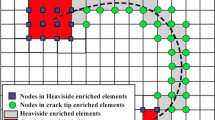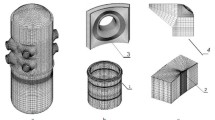Recently, much attention has been given to developing numerical modeling methods for calculations of complex nodes of structural elements, especially for the equipment of the first circuit of NPP. The use of new methods increases the accuracy of the results and significantly reduces the calculation time. This is especially important when solving the problems of modeling the processes of crack nucleation and propagation in the material, in which, in particular, local thickening of the finite element mesh is necessary. In this paper, a description of the “submodeling” technique is given, which allows one to calculate individual components of structural elements, taking into account complex geometric shapes, contact conditions, and other factors that are difficult to take into account in calculations by conventional methods. The submodeling technique was used to calculate the stressstrain state in complex components of the pressure compensator of the WWER-440 reactor unit. For this purpose, a global simplified finite element model of the pressure compensator and a detailed submodel of the injection nozzle were built, taking into account the gap between the containment and the inner surface of the nozzle, as well as contact conditions. The results showed that the submodeling technique gives more conservative results when modeling complex assemblies. Hence, its application increases the reliability of the results obtained when assessing the strength of critical structural elements, particularly the equipment of the first circuit of NPP.








Similar content being viewed by others
References
W. Dou, L. Zhang, G. Chen, and S. Stichel, “A boundary-condition-transfer method for shell-to-solid submodeling and its application in high-speed trains,” Int. J. Mech. Sci., 177, 105542 (2020).
J. H. Liu, Y. B. Liu, L. Liu, et al., “Submodeling method to study the residual stress of TBCs near the interfacial asperity on a vane,” Eng. Fail. Anal., 122, 10220 (2021).
Y. M. Zhang, D. K. Yi, Z. M. Xiao, and Z. H. Huang, “Engineering critical assessment for offshore pipelines with 3-D elliptical embedded cracks,” Eng. Fail. Anal., 51, 37–54 (2015).
S. G. Haryadi, R. K. Kapania, and R. T. Haftka, “Global/local analysis of composite plates with cracks,” Compos. Part B, 29, No. 3, 271–276 (1998).
A. Diamantoudis and G. Labeas, “Stress intensity factors of semi-elliptical surface cracks in pressure vessels by global-local finite element methodology,” Eng. Fract. Mech., 72, 1299–1312 (2005).
Y. Liu, B. Stratman, and S. Mahadevan, “Fatigue crack initiation life prediction of railroad wheels,” Int. J. Fatigue, 28, No. 7, 747–756 (2006).
E. Marenic, I. Skozrit, and Z. Tonkovic, “On the calculation of stress intensity factor and J-integrals using the submodeling technique,” J. Press. Vess.-T. ASME, 132, No. 4, 041203 (2010).
C. Albuquerque, A. L. L. Silva, A. M. P. de Jesus, and R. Calçada, “An efficient methodology for fatigue damage assessment of bridge details using modal superposition of stress intensity factors,” Int. J. Fatigue, 81, 61–77 (2015).
E. Vélez, A. Carnicero, and R. Perera, “Elemental Crack Advance assessment and verification for its use in LBB analysis,” Nucl. Eng. Des., 363, 110622 (2020).
T. W. Kim, G. M. Lee, W. S. Choi, et al., “Application of submodel method for the structural analysis of integral reactor internals,” in: Trans. of the Korean Nuclear Society Autumn Meeting (Oct. 27–28, 2005, Busan, Korea).
Passport for Pressure Compensator No. 4-1004-4 PS.
PNAE G-7-002-86. Strength Calculation Standards for Equipment and Pipelines of Nuclear Power Plants [in Russian], Energoatomizdat, Moscow (1989).
Author information
Authors and Affiliations
Corresponding author
Additional information
Translated from Problemy Mitsnosti, No. 6, pp. 102 – 108, November – December 2022
Rights and permissions
Springer Nature or its licensor (e.g. a society or other partner) holds exclusive rights to this article under a publishing agreement with the author(s) or other rightsholder(s); author self-archiving of the accepted manuscript version of this article is solely governed by the terms of such publishing agreement and applicable law.
About this article
Cite this article
Kondryakov, E.O. Application of Modern Approaches to the Numerical Modeling of the Stress-Strain State for the Strength Assessment of Complex Units of the NPP Primary Circuit Equipment. Part 1. Submodeling Methodology. Strength Mater 54, 1057–1063 (2022). https://doi.org/10.1007/s11223-023-00481-z
Received:
Published:
Issue Date:
DOI: https://doi.org/10.1007/s11223-023-00481-z




